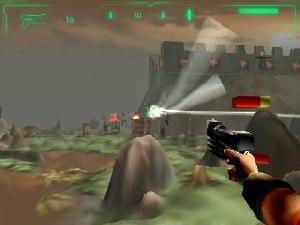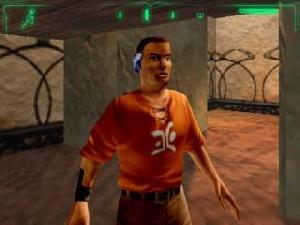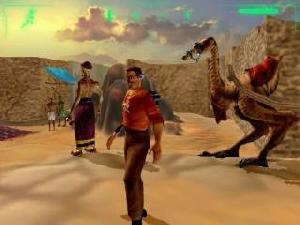An Inside Joke.
I was just thinking that there was a really funny quote I could use to start
off this review. Problem with it was, that although it was hilarious, only myself,
one of my friends, and perhaps the overworked, addled editors would get it.
That is a problem, because you, the “critically huddled masses,” would not end
up laughing. Regardless, the joke was made and you should, simply because it
was there, roll on the floors laughing, squirming around like stuck pigs. Not
laughing, eh?
You’re probably all pretty unsatisfied. I mean, the fact that something is
there does not really mean that you should react as if you encountered it…
right? It’s sort of like knowing that behind all of the crap there is a gem,
sparkling in the sunlight, but… you can’t see it, touch it, or pawn it and buy
yourself a car.
To try and
regain whatever relevance to Game Revolution this article probably already lost
[Too late. ~Ed], it occurs to me that the same quality of “it’s there,
I just can’t really see it” is the Achilles heel of the new adventure game,
Outcast. It’s a game that, for all of its features, should be an absolute
knock-down, drag-out, kick-ass ride. However, it somehow manages to cover up
much of its deserved glory in favor of keeping your attention just a little
bit longer.
To deal with the mundane first (everything you need to know about the game’s
background, which gives a context for my conceited ramblings), Outcast
is a 3rd person/1st person action-adventure set in the mysterious world of Adelpha.
It seems that scientists in the future have found a way to cross dimensional
boundaries into parallel universes. Unfortunately, the first probe sent to the
other-dimensional world of Adelpha was destroyed, and a big black hole has opened
up and will soon swallow the earth and pulverize all of the people, buildings
and teddy bears (naughty scientists, they screw up everything). You, in the
role of special military operative Cutter Slade (yes, you may roll your eyes),
are sent in with a few scientists to repair the probe… or turn the Earth into
a flapjack within a month. Once you get there, there are some complications
and so you must run all over the six continents of Adelpha, find your equipment
and teammates, help free the locals (called the Talons) from a despotic ruler,
and then save the Earth. No problem, huh?
To accomplish these goals, you must run around and swim a lot, talk with hundreds
of locals, engage in plenty of combat and go on numerous adventure game quests.
Sounds good – lots of space, lots of objectives, lots of people to talk to.
As the game begins, the sheer wealth of things to do and places to go may astound
many gamers. It is not until a little later, when you realize how silly most
of the things you have to do are, that the whole thing starts to feel like a
stalling act.
 Basically, you
Basically, you
have to enlist the help of the locals in order to accomplish most tasks. Although
they regard you as some sort of Ultima-style avatar sent from the sky, they
still cannot stop asking you to be their little errand boy. You spend most of
your time utilizing Outcast’s great gameplay system and ogling its production
values just to make a few Talon locals happy. The real meat of the game just
can’t make up the game’s 40-50 hours of gameplay time, so all these boring good
deeds are thrown in to keep you playing.
Hey, I like a long game as much as the next guy, but length for its own sake
is just boring. Half-Life wasn’t very
long but we all loved it. Would you have liked it so much if you had to go find
cigars to bring to every security guard and scientist before they would follow
you?
While you are completing these tasks, you are treated to some incredible production
values, with mixed results. The most impressive thing would be that the economic
fall of Russia was apparently a good thing for some people. Appeal, the designer
of Outcast, was able to hire the Moscow Symphony Orchestra (who have
recently, like their country, fallen on hard times) to record the movie-quality
soundtrack, and I mean a very good movie.
It is also apparent that a lot of time was put into the graphics. Outcast
has perhaps the best use of Voxel based 3D graphics ever; even better than Delta
Force. The environments are stunning at times, the atmosphere is incredible,
the viewing distance is very long, and there is a very cool water-rippling effect.
Good implementation aside, the nature of Voxels excludes 3D acceleration, and
so Outcast requires a monster of a system to run at its highest resolution,
which is only 512×384.
In other areas Outcast shines. The combat, which is best played through
the optional 1st person view (3rd person is preferable for most of the rest
of Outcast), is a more involved affair than your typical shooter. Often,
you’ll find yourself taking Cutter into assaults on enemy compounds, while having
to contend with entire groups of soldiers that are all working in harmony to
bring you down. It is actually very impressive.
It’s just a pity that the designers didn’t spend more time working out a plot
with more substance. Sure, the thousands of lines of well-acted dialogue are cool,
but why waste all of that on going to the supermarket for some butter? Outcast
almost reaches a high point for action-adventures, but falls short thanks to a
lot of wasted time. Still, the ending cues up for an obvious sequel. Drop the
voxels, forget the little pointless quests, make sure to tip those dudes in Moscow
well, and next time we may have one hell of a memorable game. Until then, only
the hardcore need apply.

-
Massive Game World
-
Lots to Do
-
Excelent Production Values
-
Lots of Pointless Quests
-
Questionable Technology/Voxels Suck







